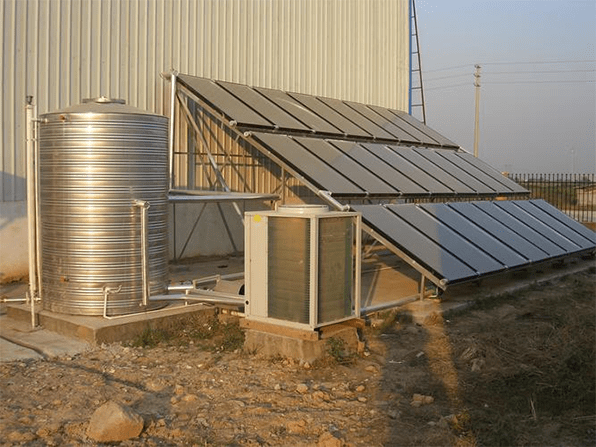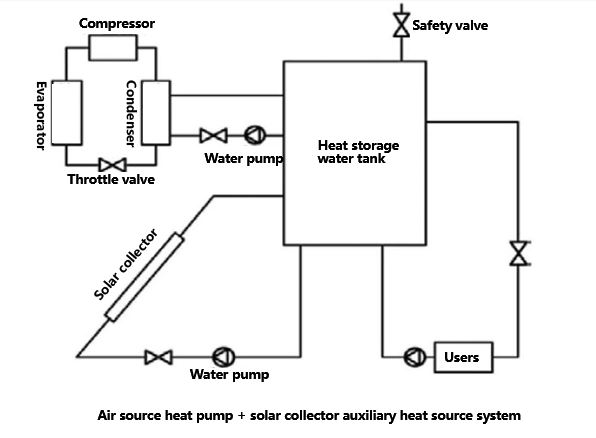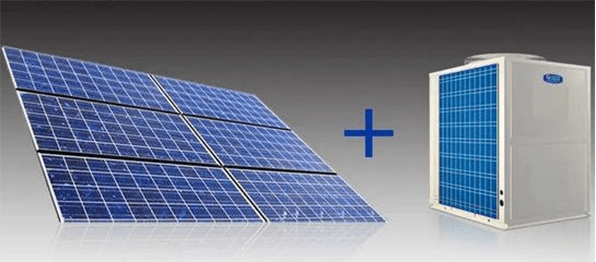
Figure 1: Solar assisted heat pump.
Solar assisted heat pumps are gaining popularity as an eco-friendly alternative to traditional heating systems. They are a combination of solar thermal collectors and heat pumps that work together to provide efficient and sustainable heating. In this article, we will explore what a solar assisted heat pump is, how it works, and its benefits.
1. What is a Solar-Assisted Heat Pump?
A solar-assisted heat pump (SAHP) is a combination of a heat pump and a solar thermal collector. The heat pump is responsible for transferring heat from one place to another, while the solar thermal collector collects solar energy and converts it into heat. The two components work together to provide efficient and sustainable heating for residential and commercial buildings.
2. How Does a Solar-Assisted Heat Pump Work?
A solar-assisted heat pump works by collecting solar energy from the sun using a solar thermal collector. The solar thermal collector is typically installed on the roof of a building and is made up of a series of tubes that contain a heat transfer fluid, such as water or antifreeze. As the sun shines on the collector, the fluid inside the tubes is heated and then pumped into a heat exchanger.
The heat exchanger is connected to the heat pump, which uses a refrigerant to transfer heat from the heat exchanger to the heating system of the building. The refrigerant absorbs the heat from the heat exchanger and then passes through a compressor, where it is compressed and its temperature is increased. The hot refrigerant is then passed through the other heat exchanger, where it transfers its heat to the heating system of the building.

Figure 2: Working principle diagram of solar-assisted heat pump.
3. Benefits of a Solar-Assisted Heat Pump
3.1 Energy Efficiency
One of the primary benefits of a solar-assisted heat pump is its energy efficiency. The solar thermal collector collects free energy from the sun, which is then used to heat the heat transfer fluid. The heat pump then transfers this heat to the heating system of the building, providing efficient and sustainable heating.
This reduces the amount of energy needed from traditional heating systems, resulting in lower energy bills and a smaller carbon footprint.
3.2 Environmentally Friendly
Another benefit of a solar-assisted heat pump is that it is environmentally friendly. By using solar energy to provide heating, SAHPs reduce the reliance on fossil fuels, which are a major contributor to greenhouse gas emissions. This means that SAHPs are a sustainable and eco-friendly alternative to traditional heating systems.
3.3 Reduced Maintenance
SAHPs require less maintenance than traditional heating systems. This is because the solar thermal collector has no moving parts and requires very little maintenance. The heat pump also has minimal moving parts, reducing the risk of breakdowns and the need for regular maintenance.

Figure 3: Solar-assisted heat pump.
3.4 Long Lifespan
SAHPs have a long lifespan, with the solar thermal collector lasting up to 25 years and the heat pump lasting up to 20 years. This means that SAHPs provide long-term, reliable heating solutions for residential and commercial buildings.
3.5 Flexible Installation
SAHPs are flexible in terms of installation, making them suitable for a wide range of buildings. The solar thermal collector can be installed on the roof of a building, while the heat pump can be installed inside or outside the building. This means that SAHPs can be installed in buildings of all shapes and sizes, providing a flexible heating and cooling solution.
4. FAQs
4.1 Can I Run a Heat Pump on Solar?
Yes, it is possible to run a heat pump on solar energy by using a solar-assisted heat pump system. A solar-assisted heat pump (SAHP) combines a heat pump and a solar thermal collector to provide efficient and sustainable heating.
The solar thermal collector collects solar energy and converts it into heat, which is then used to heat the heat transfer fluid. The heat pump then transfers the heat from the heat transfer fluid to the heating system of the building.
By using solar energy to provide heating, SAHPs reduce the reliance on fossil fuels and provide an eco-friendly heating solution. However, it is important to note that the effectiveness of a SAHP system will depend on factors such as the size of the solar thermal collector, the efficiency of the heat pump, and the climate of the location.

Figure 4: solar panels and a heat pump.
4.2 How Many Solar Panels Does It Take to Run a Heat Pump?
The number of solar panels required to run a heat pump depends on the size of the heat pump and the energy requirements of the building it is serving.
Generally, a 5kW heat pump requires around 15-20 solar panels with a total capacity of approximately 5 kW. However, this can vary depending on factors such as the climate, the orientation and angle of the solar panels, and the efficiency of the system.
It's important to consult with a professional to determine the specific number of solar panels needed for your particular heat pump and building requirements.
4.3 How Much Does a Solar Assisted Heat Pump Cost?
The cost of a solar-assisted heat pump (SAHP) will depend on various factors, such as the size and efficiency of the system, the location, and the installation costs. Generally, a SAHP will cost more upfront than a traditional heating system, but it can provide significant savings on energy bills in the long run.
According to the US Department of Energy, the cost of a typical residential SAHP system can range from $7,500 to $12,500 or more, depending on the size and complexity of the installation.
However, it is recommended to consult with a professional installer to get an accurate estimate for a specific SAHP system.
Related Info
Are Window Heat Pumps Efficient? (Window Heat Pump: Everything You Need to Know)What are the Pros and Cons of Heat Pumps
Pros and Cons of Heat Pump vs Gas Furnace: Which is Better for Your Home?
Heat Pump: Everything You Need to Know (9 Diagrams Help Better Understand Heat Pumps)
Exploring the Pros and Cons of Portable Heat Pumps for Efficient Home Heating and Cooling


